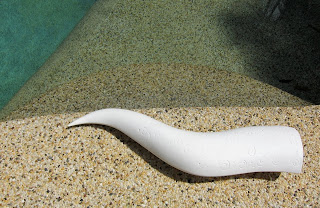...
Here are two Penny Smith ceramic lightworks in my collection. They have been exhibited both in Finland at Arabia Museum Gallery, and in Australia in Tasmania at Queen Victoria Museum and Art Gallery.
The text below, from 1996, is from the catalogue for the Tasmanian exhibition: the introduction by Ms Hilkka Hiltunen, Chairman, Arabia Foundation, Product Manager, Hackman Desgnor, Arabia.
Penny Smith in Finland, 1995
It is now almost twelve months since we closed Penny Smith's exhibition lightworks at the Arabia Museum Gallery. The exhibition aroused visitors' interest because Penny Smith was the first Australian artist to receive an invitation from the Arabia Cultural Foundation. The visitors were interested in the difference in the cultures of two countries so far apart.
Penny Smith's first and more thorough exposure to Finnish culture and design was about five years ago when she put together the touring exhibition Profiles, to which the Arabia factory sent its own products. The objects of her knowledge and interest before this had been the noted Finnish designers and artist such as Tapio Wirkkala, Timo Sarpaneva, Rut Bryk and Kaj Franck. When the opportunity arose to visit Barcelona in 1992 she stopped over in Finland on the way back, which was the first time we met and discussed the idea of a mutual project and a period of work at the Arabia factory in Helsinki.
The Arabia factories, which nowadays are part of the Hackman group, are situated in Helsinki. An art department has been operating at the factory for over sixty years, which throughout its existence has accommodated visitors. After 1989 the Arabia Cultural Foundation took over inviting artists to the factory. In 1994 the Arabia Cultural Foundation invited Penny Smith to visit Arabia for four months. The visit began in February 1995 when northern Finland was in the depths of mid-winter and the bluish twilight of the north was at its strongest. This pronounced natural and cultural difference also affected Penny's work at the factory.
A visiting artist, like Arabia's own artists, is provided with all the technical support and choice of materials possible for the factory to offer. The artist therefore has modellers, mould makers, colour development facilities and model throwers at his or her disposal. Nevertheless, it is the artist's own skills and experience which largely determine how quickly and artistically the works can be completed. Penny Smith's working style was striking in its single-midedness and professionalism. In this short time she was able to complete a magnificent display of ceramics and also to add a few glass pieces to it from her visit to the Iittala glassworks.
The factory, with all its opportunities, can present a challenge to and artist, who must concentrate on what is essential. Penny Smith decided on bone china. The bone china factory, which is within the large Arabia factory, had just started up with this new, technically difficult, but exquisite material. The delicate and beautiful variation of porcelain, bone china, also represented a new material for Penny Smith. It became an interesting acquaintanceship for the artist. Penny herself said that making the items for the exhibition was as much a learning as a creative process.
Penny produced her work as a series, duplicating a certain form for a vase as for a lamp. The artist said the shape comes from a bull's horns and was a reference to her visit to Barcelona. Many also perceived the form of a bird in the shapes, giving a warning call for all to hear. The embossed patterning of the surface and other decorative devices made the pieces individual. Professionalism and skill, both artistic and technical, are seen in Penny's works, as well as a humble approach to the material in the finishing of the pieces.
Visits and contacts are important to an artist and cannot be substituted. Visiting programmes have always been important to the Arabia factory too. Not only the artist, but also the factory and its personnel and artists are exposed to different influences. Penny Smith's visit proved once again how important it is for different cultures to meet.
Our contacts will continue and be maintained. The Arabia factory's model thrower is presently assisting students and research at the University of Tasmania. Good contacts and friendship with Penny Smith as well as with Associate Professor Les Blakebrough will surely bear fruit in future cooperation between Australian and Finnish ceramic art and design.
Ms Hillka Hiltunen
Chairman
Arabia Foundation
Product Manager
Hackman Designor, Arabia
*************************
1. Lightworks Series - IV
Slipcast and carved bone china, with slipcast, black glazed stoneware base
30 x 18 x 16 cm
Produced at Arabia, Helsinki, Finland, 1995
*************************
2. Lightworks Series - III
Slipcast bone china, with slipcast, black glazed stoneware base
59 x 20 x 26 cm
Produced at Arabia, Helsinki, Finland, 1995
*************************













No comments:
Post a Comment